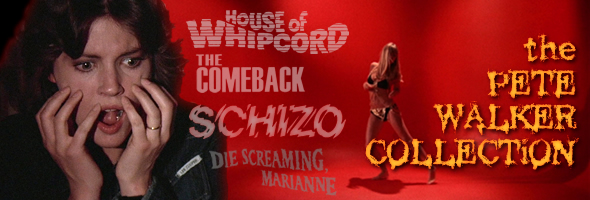

Color, 1974, 101m.
Directed by Pete Walker
Starring Ann Michelle, Penny Irving, Robert Tayman, Patrick Barr, Sheila Keith, Ivor Salter, Karen David
Kino Lorber (Blu-Ray) (US RA HD) / WS (1.66:1) (16:9), Media Blasters (US R1 NTSC), Anchor Bay (UK R0 PAL) / WS (1.78:1) (16:9), Image (US R1 NTSC)
THE COMEBACK
Color, 1978, 100m.
Directed by Pete Walker
Starring Jack Jones, Pamela Stephenson, David Doyle, Bill Owen, Sheila Keith, Holly Palance, Richard Johnson
Kino Lorber (Blu-Ray) (US RA HD) / WS (1.85:1) (16:9), Media Blasters (US R1 NTSC), Anchor Bay (UK R0 PAL)
DIE SCREAMING, MARIANNE
Color, 1971, 96m.
Directed by Pete Walker
Starring Susan George, Barry Evans, Leo Genn, Christopher Sanford, Judy Huxtable, Kenneth Hendel
Kino Lorber (Blu-Ray) (US RA HD) / WS (1.66:1) (16:9), Media Blasters (US R1 NTSC), Anchor Bay (UK R0 PAL) / WS (1.78:1) (16:9), Image (US R1 NTSC)
SCHIZO
Color, 1976, 109m.
Directed by Pete Walker
Starring Lynne Frederick, John Leyton, Stephanie Beacham, John Fraser, Jack Watson
Kino Lorber (Blu-Ray) (US RA HD), Image (US R1 NTSC), Salvation (US R0 NTSC) / WS (1.78:1) (16:9)
For a marvelous, regrettably brief period, director Pete Walker and his crew made some of the most striking, disturbing horror films to come out of 1970s British cinema. A veteran of exploitation films, Walker used lurid exploitation devices to lure viewers in and then deal with the inherent hypocrisy of "civilized" foundations ranging from organized religion to the nuclear family unit. Though his films played widely and were frequent mainstays on home video, it wasn't until he had almost given up directing in the mid-1980s when he really became something of a cult figure in horror circles, largely thanks to the strength of his four chilling collaborations with writer David McGillivray.
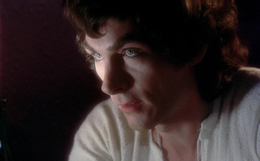
The first of those horror films, House of Whipcord, kicks off the four-disc "The Pete Walker Collection" Region A Blu-Ray set from Kino Lorber and Redemption Films, and it's an appropriate place to start. The film marks the point at which the director and writer really set their sights on the judicial and penal systems, delivering a scathing and frightening view of what happens when individuals decide to mete out justice in their own backyard. Penny Irving, a very naive young French girl exploring the swinging scene in London, hooks up with a charming, slightly sinister young man named Mark E. DeSade (Tayman). Even after Mark asks her to close her eyes, then tells her he's holding a knife to her face and swipes an ice cube across her cheek, she doesn't seem to grasp that he might not be such a wholesome character. Sure enough, Mark whisks her away to a remote estate where his mother is part of a band of concerned folks disillusioned with the British court system. Thanks to a makeshift prison ruled over by sadistic warden Sheila Keith (a wonderful Pete Walker regular), these bitter folks have managed to imprison those they deem impure or corrupt. A doddering old former judge presides over each victim, and the young girls are punished by whip for their indiscretions and escape attempts. However, our protagonist's disappearance is noticed, and her friends (including Virgin Witch's Michelle) begin the difficult process of tracking her down.
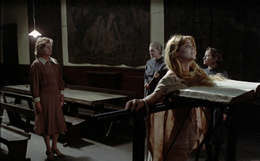 According to filmmakers like Tobe Hooper and Wes Craven, one necessity for a horror director is convincing the audience that the filmmaker himself might actually be insane. Pete Walker understood this all too well, and in his films, anyone can die -- any time, any place. House of Whipcord squarely follows this pattern, and while the ending is slightly more uplifting than his usual denouements, the overall mood of the film is one of despair and depravity reigning supreme. Even the requisite nudity is of the Caged Heat variety, deglamorized to the point of discomfort for even watching the film. Adding to the eerie ambience is an early score by the late Stanley Myers, a gifted composer with a truly odd history of dabbling in art and drive-in films.
According to filmmakers like Tobe Hooper and Wes Craven, one necessity for a horror director is convincing the audience that the filmmaker himself might actually be insane. Pete Walker understood this all too well, and in his films, anyone can die -- any time, any place. House of Whipcord squarely follows this pattern, and while the ending is slightly more uplifting than his usual denouements, the overall mood of the film is one of despair and depravity reigning supreme. Even the requisite nudity is of the Caged Heat variety, deglamorized to the point of discomfort for even watching the film. Adding to the eerie ambience is an early score by the late Stanley Myers, a gifted composer with a truly odd history of dabbling in art and drive-in films.
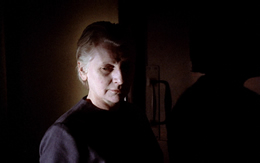
The first DVD presentation of House of Whipcord from Image was a minor step up from the incredibly murky VHS editions (released in the US by Monterey, to cite one underwhelming example) but left enormous room for improvement. The film has a tricky color scheme, with the prison sequences looking drab and sometimes very desaturated (including the opening pre-credits scene) while the cosmopolitan ones are much more vibrant and natural. An overmatted 1.78:1 transfer appeared next from Media Blasters and Anchor Bay (sourced from the same anamorphic transfer), with the latter appearing out of the gate first as part of a four-movie UK coffin set dedicated to Walker. As with many Anchor Bay UK releases of the time (including the other Walker titles), it featured the mono track along with completely superfluous fake Dolby Digital and DTS 5.1 mixes. Otherwise those two DVDs are basically the same, with a dark and often colorless look that still certainly fit the subject matter but again didn't do the film too many favors. (Click here for a sample shot from the AB/MB version, compared to the first frame grab posted above.) The 2012 Blu-Ray version is a major step up in two respects; the framing is finally presented correctly for the first time at 1.66:1, giving the film much needed breathing room on the edges but particularly at the top, while the color disparity between the two settings is much easier to appreciate thanks to a far more saturated and effective boost in both hue fidelity and detail levels. You'll still some white specks scattering around through several scenes (mainly in the first reel and a half or so), but the negative used for this transfer is easily in the best shape of any version to date. It's still not a "pretty" film by any means, but the upgrade is considerable. The audio commentary from the previous AB/MB release is carried over here, featuring Walker with director of photography Peter Jessop and Walker biographer Steven Chibnall, while a new HD interview with Walker, "Perversions of Justice," which clocks in at just under 14 minutes and offers a broader overview of the making of the film and makes a solid companion piece. In fact, all four of the Walker Blu-Rays have new video interviews by Elijah Drenner and dovetail with each other quite well. Between the commentary and featurette you get a thorough snapshot of the making of this film, which derives a great deal of tension from Walker's own relatively conservative political beliefs and his desire to make a film about persecutors whose hypocrisy is far worse than the "transgressors" they punish. His English brand of conservatism definitely worked best when mixed with McGillivray's dark and often unflinching social views, with the two best films yet to come (Frightmare and The Confessional, both of which are absent here but will hopefully appear in a second volume soon). As with the other three Blu-Rays, this also contains trailers for all of the films included except for Schizo.
The only minor debit here is that, unlike the prior MB/AB discs, no English subtitle options are offered.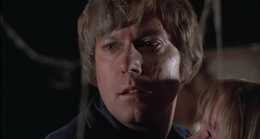
The second film in the set, The Comeback, was released in 1978 and marked Walker's first horror film after his split with McGillivray. It would also prove to be his final independent, self-financed genre effort, followed only by the moody 1979 drama Home Before Midnight and the 1983 Cannon horror all-star favorite House of the Long Shadows. Sort of a pop music slasher/old dark house mash up, The Comeback (origi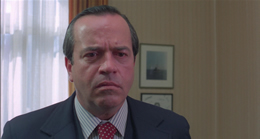 nally planned to be title The Day the Screaming Stopped) features crooner Jack Jones (who suggested that title change) as Nick Cooper, who's moved from Los Angeles to England to work on his new album. However, there's a scythe-wielding maniac in a creepy hag mask on the loose in the vicinity who's just hacked up Nick's ex-wife, and Nick's American producer (Doyle, aka Bosley from Charlie's Angels) has fixed him up with a remote, huge mansion to crack down on some new songs. The place is run by a spooky old couple (Keith, of course, and Owen), while Nick also gets a blonde girlfriend courtesy of pretty secretary Linda (Superman III's Stephenson). Disturbances in the night prove to be more than a little disruptive, especially considering the dead bodies moldering away within the hidden confines of the house. Who's behind it, and why is Nick next on the killer's list?
nally planned to be title The Day the Screaming Stopped) features crooner Jack Jones (who suggested that title change) as Nick Cooper, who's moved from Los Angeles to England to work on his new album. However, there's a scythe-wielding maniac in a creepy hag mask on the loose in the vicinity who's just hacked up Nick's ex-wife, and Nick's American producer (Doyle, aka Bosley from Charlie's Angels) has fixed him up with a remote, huge mansion to crack down on some new songs. The place is run by a spooky old couple (Keith, of course, and Owen), while Nick also gets a blonde girlfriend courtesy of pretty secretary Linda (Superman III's Stephenson). Disturbances in the night prove to be more than a little disruptive, especially considering the dead bodies moldering away within the hidden confines of the house. Who's behind it, and why is Nick next on the killer's list?
Much more of a traditional horror film than Walker's previous efforts, The Comeback is still a solid good time and remains drenched in that eerie, late '70s British ambience with lots of mist and pale sunlight. Jones' singing may not go over well with most of the target audience for this film, but the murder and shock sequences are executed with a great deal of panache including a very lively climax complete with a couple of highly effective jolts. The cast is game as well (with Keith stealing all of her scenes as usual), with the weird casting of Doyle paying off with a perverse twist whose imagery will, for better or worse, 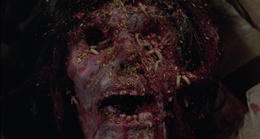 stick in your memory for way too long.
stick in your memory for way too long.
Of all of Walker's horror output, this one has easily fared the worst on video before its Blu-Ray resuscitation. The Anchor Bay UK and Media Blasters versions were taken from a sick-looking open matte transfer with very weak colors (click here for a sample shot comparable to one of the new frame grabs here) and even weaker black levels; it was a minor step up from the comparatively scarce VHS versions, but not by much. The Blu-Ray version will definitely come as something of a shock, as it reveals t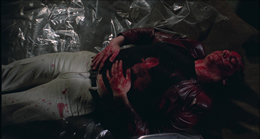 he film to actually be quite well shot and colorful throughout. Extras-wise it's a similar story here with the previous Walker commentary carried over (this time moderated by Jonathan Rigby) while a new 13-minute HD video featurette, "Slasher Serenade," features Walker and Jones looking back at the making of the film. Again the two extras match up well and deliver plenty of fun info: Jones' female fans were aghast at his dropping of the "f bomb" in the movie; Walker's intention to make this a more straightforward "terror film" (his preferred term) given Jones' older fan base; and of course the mind-boggling original idea for the film to star Bryan Ferry.
he film to actually be quite well shot and colorful throughout. Extras-wise it's a similar story here with the previous Walker commentary carried over (this time moderated by Jonathan Rigby) while a new 13-minute HD video featurette, "Slasher Serenade," features Walker and Jones looking back at the making of the film. Again the two extras match up well and deliver plenty of fun info: Jones' female fans were aghast at his dropping of the "f bomb" in the movie; Walker's intention to make this a more straightforward "terror film" (his preferred term) given Jones' older fan base; and of course the mind-boggling original idea for the film to star Bryan Ferry.
Now we jump back to Walker's first genuine thriller, Die Screaming Marianne from 1971. Walker had dabbled in crime films before with Man of Violence and The Big Switch (available in a terrific Blu-Ray double feature in the UK), but this one finds him jumping into territory closer to the Hitchcock-influenced continental suspensers from Hammer like Maniac and Crescendo, which would play well with this one. 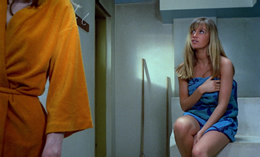 Though not a horror film by any stretch and devoid of nudity and containing only one quick instance of bloodshed, the film is a generally absorbing yarn, good for passing a slow afternoon and particularly interesting for the basic ideas which would be fleshed out in Walker's later masterpieces.
Though not a horror film by any stretch and devoid of nudity and containing only one quick instance of bloodshed, the film is a generally absorbing yarn, good for passing a slow afternoon and particularly interesting for the basic ideas which would be fleshed out in Walker's later masterpieces.
Poor Marianne (Straw Dogs' George) is on the run. Abandoning her job as a go go dancer in Portugal, she hitches a ride with sleazy Sebastian (Sanford), who asks her to marry him after they've been shacking up in London for two weeks. She reluctantly agrees but for intricate reasons winds up engaged to Sebastian's more wholesome and handsome friend, Eli (late British sex comedy staple Evans). It turns out Sebastian's motives have been less than honorable, as he's been scheming to return Marianne to her corrupt ex-judge father (A Lizard in a Woman's Skin's Genn) who lives in exile in a Portuguese hacienda with Marianne's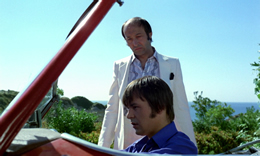 homicidal, incest-loving half sister, Hildegarde (Huxtable). Marianne and Eli become bona fide lovers while Sebastian and Marianne's family scheme to get her back before her twenty-first birthday, at which time she will gain access to a mysterious bank account set up by her late mother. Double crossing, murder, mayhem, and steam room shenanigans ensue.
homicidal, incest-loving half sister, Hildegarde (Huxtable). Marianne and Eli become bona fide lovers while Sebastian and Marianne's family scheme to get her back before her twenty-first birthday, at which time she will gain access to a mysterious bank account set up by her late mother. Double crossing, murder, mayhem, and steam room shenanigans ensue.
Despite the lurid title, Die Screaming Marianne keeps events moving at a low boil rather than a fever pitch. The cast is great fun to watch, with Evans and George making a surprisingly engaging couple, and Walker regular Anthony Sharpe (who later took the reins in The Confessional) stands out as, of course, a minister. Only Genn's performance proves to be a major distraction thanks to his annoying habit of incoherently mumbling his lines right down his chin. The first hour is the most enjoyable, thanks to the swinging London scenery, the jazzy score, and Walker's gaudy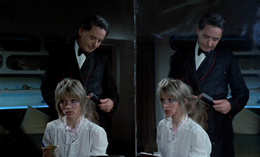 optical tricks, including split screen and bizarre wipes. The last half hour stumbles somewhat after everyone's motives have been exposed, leaving the bad guys to chase George around in circles until the 90 minute mark has been reached. The script also tries to gloss over a few nasty holes; in particular, George's escape from one near death situation is left annoyingly vague. Furthermore, Evans expresses surprise no less than three times upon learning that the judge is George's father, for no good reason whatsoever. Structural problems aside, Walker at least manages to keep the story under control and, in his typical fashion, winds things up on a bitter, ironic note.
optical tricks, including split screen and bizarre wipes. The last half hour stumbles somewhat after everyone's motives have been exposed, leaving the bad guys to chase George around in circles until the 90 minute mark has been reached. The script also tries to gloss over a few nasty holes; in particular, George's escape from one near death situation is left annoyingly vague. Furthermore, Evans expresses surprise no less than three times upon learning that the judge is George's father, for no good reason whatsoever. Structural problems aside, Walker at least manages to keep the story under control and, in his typical fashion, winds things up on a bitter, ironic note.
Weirdly, some early VHS versions of this film (including the most common one from Unicorn) bluntly dropped almost all of the third reel, including Sebastian's first dinner with the judge, rendering most of what follows nonsensical and barely running over 80 minutes in length. The first DVD from Image looked vastly superior and featured the complete version, as do all subsequent digital incarnations. Walker shot the film open matte, and the split screen sequence clearly indicates compositions intended to be masked at 1.66:1. The extra information also proves to be slightly distracting, as when George's bra is clearly visible while she's supposed to be taking a bubble bath. The later Media Blasters and Anchor Bay editions overcompensate by matting it to 1.78:1, which works better but looks too cramped. The Blu-Ray finally gets things right with the correct framing, and while those ultra-vivid colors have always fared pretty well, they're flat out startling here (especially George's groovy dance over the Hammond organ-fueled opening credits, one of the highlights of the film). The prior Walker/Rigby audio commentary appears here again and makes for good listening, while the new Walker interview featurette, "An Eye for Terror, Part I," has nothing to do specifically with this film but covers his general thoughts on his directorial career. Most valuable are his comments about the difficulties of the process, with each film taking five years off his life. He calls the profession a young man's game and also shares his reasons for self-financing almost all of his films; it's a nice primer and will hopefully be continued in a second Blu-Ray set, which seems likely given the title.
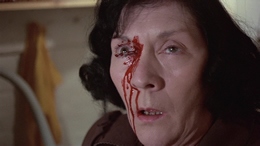 Finally we reach Blu-Ray disc four, which marks the final Walker/McGillivray pairing: Schizo. The closest thing to a pure slasher film in either man's filmography, it's also a rollicking UK spin on the giallo formula with plenty of shocking murders, psychological aberrations, and corkscrew plot twists that stretch credibility way past the breaking point (but hilariously so). In "North-East England, June 18th," some crazy old guy in a red ski cap is planning to do something really, really nasty. How do we know? Because he lives in a boarding house, makes
Finally we reach Blu-Ray disc four, which marks the final Walker/McGillivray pairing: Schizo. The closest thing to a pure slasher film in either man's filmography, it's also a rollicking UK spin on the giallo formula with plenty of shocking murders, psychological aberrations, and corkscrew plot twists that stretch credibility way past the breaking point (but hilariously so). In "North-East England, June 18th," some crazy old guy in a red ski cap is planning to do something really, really nasty. How do we know? Because he lives in a boarding house, makes 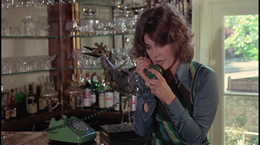 crazy swirly scratches in the daily newspaper with a ballpoint pen, and packs a machete in his suitcase. Ah, yes, and as the opening title card screams out, he's SCHIZO! That's how things appear, anyway, as this released murderer proceeds to stalk pretty ice skater Samantha (played by the late Frederick, star of Phase IV and the last, most notorious Mrs. Peter Sellers), who's engaged to be married to the amiable and incredibly dull Alan Falconer (Leyton) with whom she lives in an apartment serviced by a particularly perverse interior decorator. Her best friend, Beth (Beacham), is a happy camper, too, which makes it all the more disturbing when Samantha realizes that the crazy SCHIZO -- who's prone to leaving bloody cutlery next to her wedding cake -- is in fact her mother's lunatic lover (Fraser), sent up the river years ago for brutally hacking up Sam's mom with a knife. Soon the bodies being piling up all around, and when visits to a psychiatrist and a psychic fail to pan out, Samantha must come face to face against her gruesome past and uncover the SCHIZO truth.
crazy swirly scratches in the daily newspaper with a ballpoint pen, and packs a machete in his suitcase. Ah, yes, and as the opening title card screams out, he's SCHIZO! That's how things appear, anyway, as this released murderer proceeds to stalk pretty ice skater Samantha (played by the late Frederick, star of Phase IV and the last, most notorious Mrs. Peter Sellers), who's engaged to be married to the amiable and incredibly dull Alan Falconer (Leyton) with whom she lives in an apartment serviced by a particularly perverse interior decorator. Her best friend, Beth (Beacham), is a happy camper, too, which makes it all the more disturbing when Samantha realizes that the crazy SCHIZO -- who's prone to leaving bloody cutlery next to her wedding cake -- is in fact her mother's lunatic lover (Fraser), sent up the river years ago for brutally hacking up Sam's mom with a knife. Soon the bodies being piling up all around, and when visits to a psychiatrist and a psychic fail to pan out, Samantha must come face to face against her gruesome past and uncover the SCHIZO truth.
Devoid of the savage social commentary which characterized Pete Walker's previous horror films, this is an unabashed shock delivery system with plenty of blood and breasts prominently throughout (in some cases at the same time). That beloved Walker pessimism still manages to rear its head during the nasty (and not terribly persuasive) finale, which of course features a big twist and an ironically downbeat coda. Most critics tend to dismiss this film as a lesser Walker effort, but when taken in the right spirit, it's still wildly entertaining (albeit way longer than usual) with a highly non-PC attitude (just check out that opening monologue). The seance sequence alone is one of the creepiest things Walker ever put on the film, and the pulpy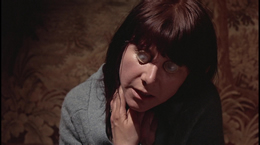 thrills come fast and furious from Frederick's naked-in-peril shower scene to a nasty close encounter between a knitting needle and an eye socket. The score by Stanley Myers isn't exactly subtle, either, as it ladles on the shrieking strings whenever Samantha starts to look a little nervous. It's not great art, but hack and slash fans will have a blast.
thrills come fast and furious from Frederick's naked-in-peril shower scene to a nasty close encounter between a knitting needle and an eye socket. The score by Stanley Myers isn't exactly subtle, either, as it ladles on the shrieking strings whenever Samantha starts to look a little nervous. It's not great art, but hack and slash fans will have a blast.
Often censored during its theatrical release (with as much as 11 minutes shorn from its running time in some territories), Schizo has thankfully appeared in its intact, 109-minute version for most of its various video incarnations over the years, with only the cranky BBFC keeping it scissored down in the UK. The first no-frills DVD release from Image only stayed on the market for a few years and then began demanding stupid amounts of money from online sellers, so the American reissue courtesy of Salvation later appeared from apparently the same source, a UK print using the Warner Brothers logo. For some reason this edition looks a bit darker and softer, particularly during the opening exterior shots; that may or may not be beneficial considering the atmosphere of the film, as it certainly gives it a scummier ambience. The mono audio sounds fine. There still isn't much here extras-wise, though you do get a small stills gallery, a Walker filmography, and the usual Redemption promotional promos and book teaser. On the other hand, the Blu-Ray is (like the previous titles) transferred from the original negative and is far cleaner while offering a tremendous amount of additional image detail. The opening sequence is still deliberately grainy and very diffused, but after the credits it's a gorgeous transfer and probably the strongest of the quartet. It looks astonishingly crisp and vivid for almost the entire running time, and the mono audio (LPCM, like the other three) sounds great with every violent violin slash intact. Previous releases had no Walker input on this film at all, but thankfully the Blu-Ray has a new 12-minute HD featurette, "My Sweet Schizo," in which he talks pretty candidly about McGillivray's issues with the primary twist, his attitudes to the levels of violence depicted in his films, and the big issue with the film's actual title. All in all, a fantastic set of titles that hopefully only marks the first half of what's to come; interestingly there's no DVD option out there from Kino, so this should be enough to make plenty of Blu-Ray holdout horror fans finally take the plunge.
![]()